Thickness range for performance qualification (welder qualification test):
ASME BPVC Section IX has provided guidelines for the thickness range up to which a welder can weld. This can be found in Table – QW 452.1(b) of ASME BPVC Section IX. A simplified version of that table is given below;
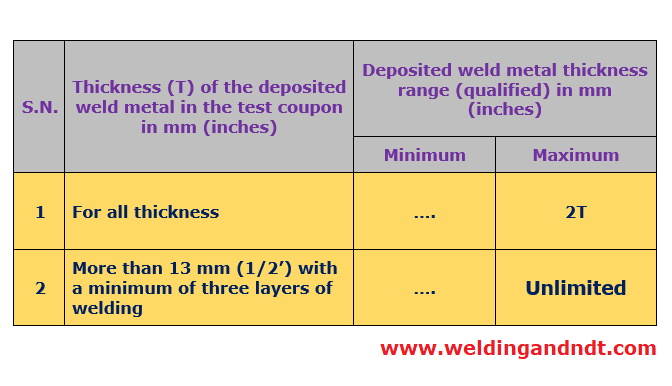
According to this table, three important points can be drawn:
- The maximum thickness which a welder can weld is 2T, where T is the thickness of the deposited weld metal on the test coupon by that welder.
- There are no criteria for minimum thickness
- If a welder deposits weld metal of thickness 13 mm or more (with a minimum of three layers) then he/she qualifies for an unlimited thickness, but the maximum thickness which the welder can weld shall not be more than that specified in the WPS range.
For the range of outside diameter of pipes (Groove weld) for which a welder can weld is also provided in ASME BPVC Section IX. The table which we have to refer to for this is QW 452.3. A simplified version of that table is given below;
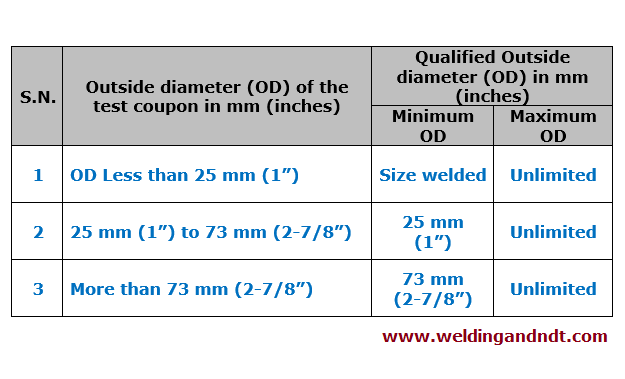
From the above table we can conclude that;
- If the outside diameter of the test coupon is less than 25 mm (or 1 inch) then the minimum outside diameter for which the welder gets qualified is the same that of the test coupon and the maximum outside diameter which he can weld is Unlimited.
- For outside diameter, 25 mm (or 1 inch) to 73 mm (or 2-7/8 inch), the minimum Outside diameter for which the welder gets qualified is 25 mm (or 1 inch) and the maximum outside diameter which he can weld is Unlimited.
- If the outside diameter of the test coupon is more than 73 mm (or 2-7/8 inch) then the minimum Outside diameter for which the welder gets qualified is 73 mm (or 2-7/8 inch) and the maximum outside diameter which he can weld is Unlimited.
- One very important point can be observed from this table that ASME BPVC has not given any limitation for the maximum outside diameter, there is the only restriction for the minimum outside diameter of the pipe which a welder can weld.
Thickness range for procedure qualification (Procedure qualification record):
To qualify a proposed Welding procedure specification (PWPS), we need to carry out the procedure qualification which includes the following steps;
- Preparation of test coupon
- welding of test coupon and
- sending it to the lab for destructive test
During the welding of the test coupon, all real-time data is recorded and after a satisfactory lab test report, the welding procedure specification (WPS) gets qualified. It is also called as procedure qualification and all the real-time welding data along-with the lab test report is known as Procedure qualification record (PQR).
Now, we have a thickness limit for procedure qualification too. It means that a particular welding procedure specification (WPS) gets qualified for a particular thickness range and if we have to weld beyond that thickness range then we need a new WPS and procedure qualification.
The thickness range for which a Welding procedure specification (WPS) gets qualified is given in ASME BPVC section IX Table QW 451.1. A simplified version of that table is given below;
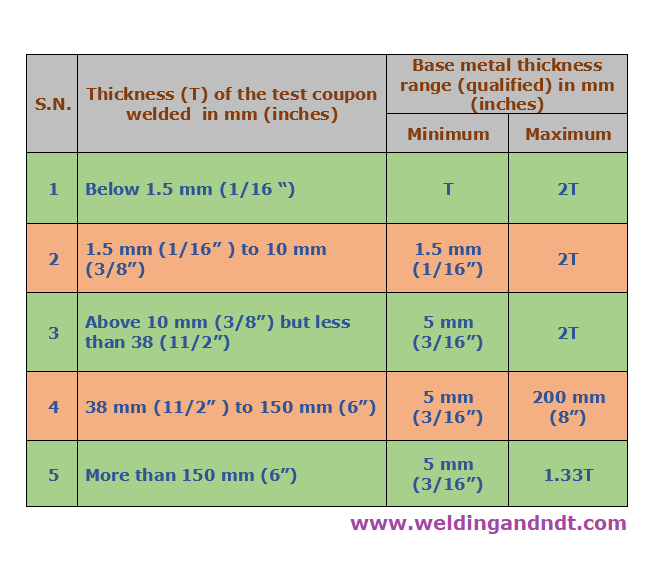
From the above table, one can easily find out the thickness range for which a Welding procedure can be qualified or a welding engineer can prepare a welding procedure specification (WPS) accordingly.
One important point to be noted that for performance qualification (welder qualification) the thickness which is considered is that of the deposited weld metal but in the case of procedure qualification, it is the thickness of the test coupon which is considered.
Also read: How to write a welding procedure specification (WPS)
Also read: P-number, F-number, and A-number in welding
Also read: Welding Defects
Also read: Welding Symbols
Note: The purpose of this article is to give basic information to the readers, for terms and conditions (in detail), Please refer to ASME Section IX.
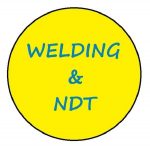
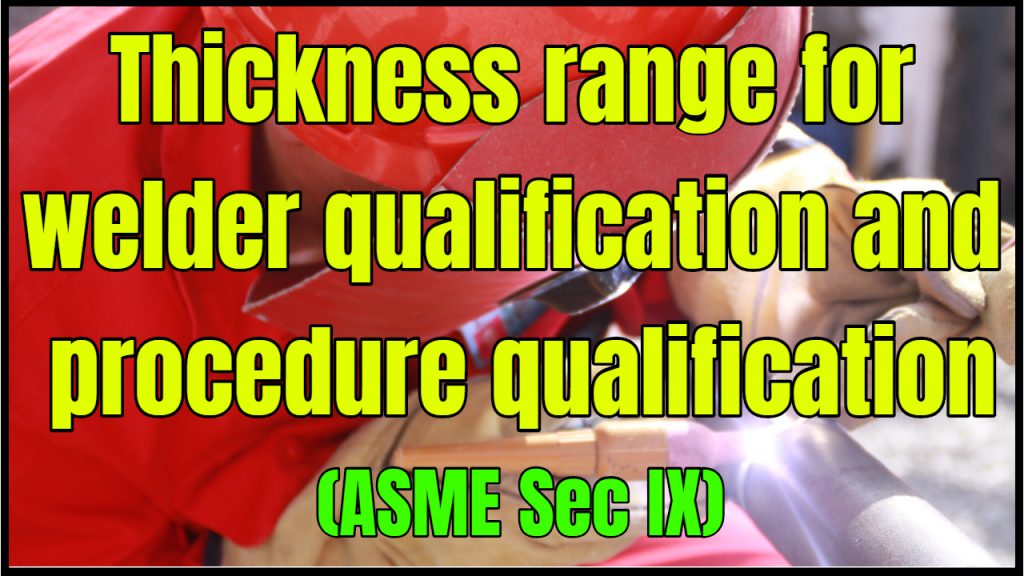
Great work, made much easy.
Great work, made much easy.
sir in the case of IMPACT test or PWHT condition how much range should be qualified for test coupon of thickness 20 mm
Sir if I need to qualify a PQR which requires impact test. What is the minimum thickness required for impact testing. Explain with ana example
Excellent easy to understand for beginners. Thanks.
Great explanation ever i met thank you sir,for simplifying
Dear Sir,
Please Share what will be the thickness range qualified if Dissimilar Thickness of Base Metal coupon
10 mm thk to 25 mm thk or any other
Explain QW 202.4 (b) in simple words
Please upload the video for Thickness range for welder qualification and procedure qualification as per AWS D1.1 and also base metal Group No qualified for the same.
Very Good explanation , Thank you
Thank you
Thank you
Dear Sir,
Your videos are very good and useful to every one.
I request to make one video presentation on “on what basic piping welder qualification done for any construction project”
For welder test of plate groove and IS 2062 material. Can used 7018-1 electrodes for this welder test. Please confirm and suggest..
Under which clause in ASME Section IX , the range of qualified positions is mentioned?
which thickness would rule as the qualifying thickness
If a pqr of moc is A333-6 GR.B and impact test rquired with T:3.76 qualified range as per table 323.3.1 box A5 is T/2 to T+6 refer to B31.3 ? I think no need refer to Qw-403.6 when me the requirement of Qw-403.10 according to interpretation 15-23
Please help me
Can you please provide the filler metal and electrode rod required for CuNi pipe or plate welding for SMAW and GTAW / GMAW welding
PLEASE TELL ABOUT THE SELECTION OF FILLER METAL FOR DISSIMILAR MATERIAL WELDING
If I pass 2 out 3 welding test can I still be Hired by company they don’t do much stick rod n plants and past few jobs I been on long as I passed my tig carbon and stainless steel I was hired?